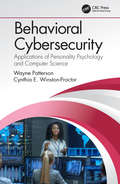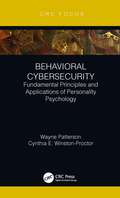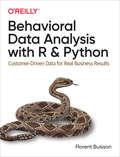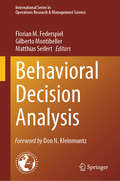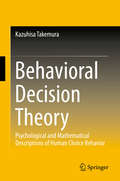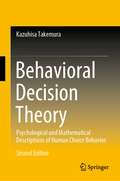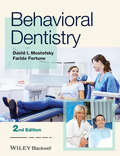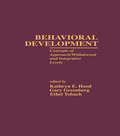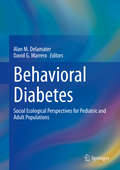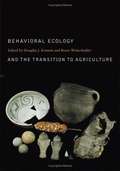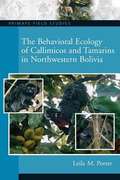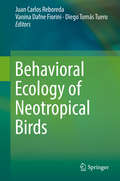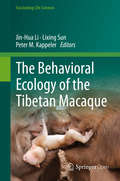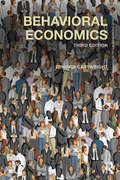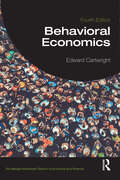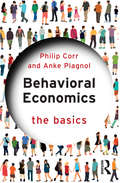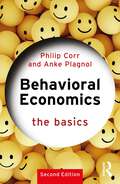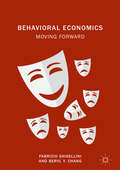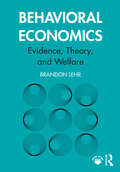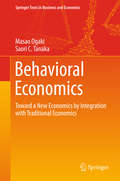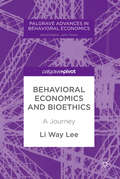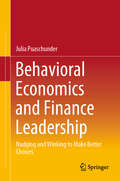- Table View
- List View
Behavioral Cybersecurity: Applications of Personality Psychology and Computer Science
by Wayne Patterson Cynthia E. Winston-ProctorSince the introduction and proliferation of the Internet, problems involved with maintaining cybersecurity has grown exponentially, and have evolved into many forms of exploitation. Yet, Cybersecurity has had far too little study and research. Virtually all of the Research that has taken place in cybersecurity over many years, has been done by those with computer science, electrical engineering, and mathematics backgrounds. However, many cybersecurity researchers have come to realize that to gain a full understanding of how to protect a cyber environment requires not only the knowledge of those researchers in computer science, engineering and mathematics, but those who have a deeper understanding of human behavior: researchers with expertise in the various branches of behavioral science, such as psychology, behavioral economics, and other aspects of brain science. The authors, one a computer scientist and the other a psychologist, have attempted over the past several years to understand the contributions that each approach to cybersecurity problems can benefit from this integrated approach that we have tended to call "behavioral cybersecurity." The authors believe that the research and curriculum approaches developed from this integrated approach provide a first book with this approach to cybersecurity. This book incorporates traditional technical computational and analytic approaches to cybersecurity, and also psychological and human factors approaches, as well. Features Discusses profiling approaches and risk management Includes case studies of major cybersecurity events and "Fake News" Presents analyses of password attacks and defenses Addresses game theory, behavioral economics and their application to cybersecurity Supplies research into attacker/defender personality and motivation traits Techniques for measuring cyber attacks/defenses using crypto and stego
Behavioral Cybersecurity: Fundamental Principles and Applications of Personality Psychology
by Wayne Patterson Cynthia E. Winston-ProctorThis book discusses the role of human personality in the study of behavioral cybersecurity for non-specialists. Since the introduction and proliferation of the Internet, cybersecurity maintenance issues have grown exponentially. The importance of behavioral cybersecurity has recently been amplified by current events, such as misinformation and cyber-attacks related to election interference in the United States and internationally. More recently, similar issues have occurred in the context of the COVID-19 pandemic. The book presents profiling approaches, offers case studies of major cybersecurity events and provides analysis of password attacks and defenses. Discussing psychological methods used to assess behavioral cybersecurity, alongside risk management, the book also describes game theory and its applications, explores the role of cryptology and steganography in attack and defense scenarios and brings the reader up to date with current research into motivation and attacker/defender personality traits. Written for practitioners in the field, alongside nonspecialists with little prior knowledge of cybersecurity, computer science, or psychology, the book will be of interest to all who need to protect their computing environment from cyber-attacks. The book also provides source materials for courses in this growing area of behavioral cybersecurity.
Behavioral Data Analysis with R and Python: Customer-driven Data For Real Business Results
by Florent BuissonHarness the full power of the behavioral data in your company by learning tools specifically designed for behavioral data analysis. Common data science algorithms and predictive analytics tools treat customer behavioral data, such as clicks on a website or purchases in a supermarket, the same as any other data. Instead, this practical guide introduces powerful methods specifically tailored for behavioral data analysis.Advanced experimental design helps you get the most out of your A/B tests, while causal diagrams allow you to tease out the causes of behaviors even when you can't run experiments. Written in an accessible style for data scientists, business analysts, and behavioral scientists, thispractical book provides complete examples and exercises in R and Python to help you gain more insight from your data--immediately.Understand the specifics of behavioral dataExplore the differences between measurement and predictionLearn how to clean and prepare behavioral dataDesign and analyze experiments to drive optimal business decisionsUse behavioral data to understand and measure cause and effectSegment customers in a transparent and insightful way
Behavioral Decision Analysis (International Series in Operations Research & Management Science #350)
by Matthias Seifert Gilberto Montibeller Florian M. FederspielThis book lays out a foundation and taxonomy for Behavioral Decision Analysis, featuring representative work across various domains. Traditional research in the domain of Decision Analysis has focused on the design and application of logically consistent tools to support decision makers during the process of structuring problem complexity, modeling uncertainty, generating predictions, eliciting preferences, and, ultimately, making better decisions. Two commonly held assumptions are that the decision maker’s cognitive belief system is fully accessible and that this system can be understood and formalized by trained analysts. However, in past years, an active line of research has emerged studying instances in which such assumptions may not hold. This book unites this community under the common theme of Behavioral Decision Analysis. The taxonomy used in this book categorizes research based on task focus (prediction or decision) and behavioral level (individual or group). Two theoretical lenses that lie at the interface between (1) normative and descriptive research, and (2) normative and prescriptive research are introduced. The book then proceeds to highlight representative works across the two lenses focused on individual and group-level decision making. Featuring various methodologies and applications, the book serves as a reference for researchers, students, and professionals across different disciplines with a common interest in Behavioral Decision Analysis.
Behavioral Decision Theory: Psychological and Mathematical Descriptions of Human Choice Behavior
by Kazuhisa TakemuraThis book provides an overview of behavioral decision theory and related research findings. In brief, behavioral decision theory is a general term for descriptive theories to explain the psychological knowledge related to decision-making behavior. It is called a theory, but actually it is a combination of various psychological theories, for which no axiomatic systems, such as the utility theory widely used in economics, have been established; it is often limited to qualitative knowledge. However, as suggested in the studies of H. A. Simon, who won the Nobel Prize for Economics in 1978, and D. Kahneman, who won the prize in 2002, the psychological methodology and knowledge of behavioral decision theory have been applied widely in such fields as economics, business administration, and engineering, and are expected to become more useful in the future. This book explains various behavioral decision theories related to decision-making processes. Numerous models have been proposed to explain the psychological processes related to such a selection of decision strategies, and this book also introduces some new models that are useful to explain decision-making processes. The book concludes with speculation about the future of modern behavioral decision theories while referring to their relation to fields associated with neuroscience, such as neuroeconomics, that have been developed in recent years. In addition, each chapter includes a bibliography that can be referred to when studying more details related to behavioral decision theory. Reading this book requires no advanced expertise; nonetheless, an introductory knowledge of psychology, business administration, and economics, and approximately a high school graduate's level of mathematics should facilitate the reader's comprehension of the content.
Behavioral Decision Theory: Psychological and Mathematical Descriptions of Human Choice Behavior
by Kazuhisa TakemuraThis book is the second edition of Behavioral Decision Theory, published in 2014. The main approach and structure of this book have been retained in the new edition. However, this second edition provides a fresh overview of the idea of behavioral decision theory and related research findings such as theoretical and empirical discoveries of preference formation, time discounting, social interaction, and social decision making. The book covers a wide range from classical to relatively recent major studies concerning behavioral decision theory, which, in brief, is a general term for descriptive theories to explain the psychological knowledge related to people’s decision-making behavior. It is called a theory but is actually a combination of various psychological theories, for which no axiomatic systems—such as those associated with the utility theory widely used in economics—have been established.The utility theory is often limited to qualitative knowledge; however, as the studies of Nobel laureates H. A. Simon, D. Kahneman, and R. Thaler have suggested, the psychological methodology and knowledge of behavioral decision theory have been applied widely in such fields as economics, business administration, and engineering and are expected to become even more useful in the future. Research into people’s decision making represents an important part in those fields, various aspects of which overlap with the scope of behavioral decision theory. This theory is closely related to behavioral economics and behavioral finance, which have come into greater use in recent years. This book will appeal especially to graduate students, advanced undergraduate students, and researchers who are interested in decision-making phenomena.
Behavioral Dentistry
by David I. Mostofsky Farida FortuneBehavioral Dentistry, Second Edition, surveys the vast and absorbing topic of the role of behavioral science in the study and clinical practice of dentistry. An understanding of social sciences has long been a central part of dental education, and essential for developing a clinician's appreciation of human behavior as it affects efficient dental treatment. This book gathers together contributions from leading experts in each of the major subspecialties of behavioral dentistry. Its aim is not merely to provide the student and clinician with a comprehensive review of the impressive literature or discussion of the theoretical background to the subject, but also with a practical guide to adapting the latest techniques and protocols and applying them to day-to-day clinical practice.This second edition of Behavioral Dentistry discusses biobehavioral processes, including the psychobiology of inflammation and pain, oral health and quality of life, saliva health, and hypnosis in dentistry. The book goes on to examine anxiety, fear, and dental and chronic orofacial pain, and then reviews techniques for designing and managing behavior change. It concludes with a section on professional practice, including care of special needs, geriatric, and diabetic patients, and interpersonal communication in dental education.
Behavioral Development: Concepts of Approach/Withdrawal and Integrative Levels (Research in Developmental and Comparative Psychology #Vol. 1)
by Kathryn E. Hood Gary Greenberg Ethel TobachFirst Published in 1995. Behavioral Development is Volume 1 in the Research and Developmental and Comparative Psychology series - dedicated to honour the contributions of T. C. Schneirla. This volume represents the substantive content of the Fifth T. C. Schneirla Conference, held in November of 1989. The volume is divided into three parts: the significance of the intensity of the adequate stimulus; the process of development and the concept of integrative levels. Schneirla is still recognized as one of the foremost theoreticians in comparative psychology, and the rebirth of interest in comparative psychology is evident.
Behavioral Diabetes: Social Ecological Perspectives for Pediatric and Adult Populations
by David G. Marrero Alan M. DelamaterThis book presents an up-to-date review of behavioral factors in diabetes management across the lifespan: an update on medical management, epidemiology, and prognosis, and utilize an ecological framework to address various aspects of diabetes management for children and adults on the individual, social, community and medical system, and policy levels. The individual level examines biobehavioral and neuroendocrine factors for their role in the etiology of diabetes, as well as various demographic factors involved in health disparities, and specific psychological issues including distress and quality of life, depression and anxiety, eating disorders, and intervention approaches. Zooming out, the social level addresses the role of social support and family influences as well as group and family interventions to promote more effective diabetes management. The community level addresses medical system factors including the patient-physician relationship and transition programs, as well as community and school-based prevention programs. Finally, chapters also address how the policy level impacts diabetes management considering the role of health care, insurance, and school and workplace policy. Topics featured in this book include: Neuroendocrine and biobehavioral influences on diabetes Eating disorders in individuals with diabetesFamily influences and family therapies for children and adults with diabetesDepression and anxiety in children and adults with diabetes Behavioral Diabetes is a must-have resource for researchers, graduate students and fellows, as well as clinicians, therapists, and other practitioners involved in diabetes management across the lifespan. A secondary audience comprises individuals working in the community and policy levels, including but not limited to health care and medical systems administrators, as well as school and workplace policymakers. “This book is a comprehensive overview of the extremely important topic of behavioral diabetes. The issues encompassed in this book have evolved greatly over the last few decades and the editors have done a spectacular job in having the key experts on each of the many topics review the literature while at the same time keeping it practical for both clinicians and researchers.”--Irl B. Hirsch, MD, University of Washington, Seattle
Behavioral Ecology and the Transition to Agriculture
by Douglas J. Kennett Bruce WinterhalderThis innovative volume is the first collective effort by archaeologists and ethnographers to use concepts and models from human behavioral ecology to explore one of the most consequential transitions in human history: the origins of agriculture. Carefully balancing theory and detailed empirical study, and drawing from a series of ethnographic and archaeological case studies from eleven locations--including North and South America, Mesoamerica, Europe, the Near East, Africa, and the Pacific--the contributors to this volume examine the transition from hunting and gathering to farming and herding using a broad set of analytical models and concepts. These include diet breadth, central place foraging, ideal free distribution, discounting, risk sensitivity, population ecology, and costly signaling. An introductory chapter both charts the basics of the theory and notes areas of rapid advance in our understanding of how human subsistence systems evolve. Two concluding chapters by senior archaeologists reflect on the potential for human behavioral ecology to explain domestication and the transition from foraging to farming.
The Behavioral Ecology of Callimicos and Tamarins in Northwestern Bolivia
by Leila M. PorterThe Behavioral Ecology of Callimicos and Tamarins in Northwestern Bolivia offers students a scholary and relevant study of these rainforest dwellers.
Behavioral Ecology of Neotropical Birds
by Juan Carlos Reboreda Vanina Dafne Fiorini Diego Tomás TueroThis book covers central aspects of behavioral ecology, including sexual selection, social and genetic mating systems, cooperative breeding, brood parasitism, brood reduction, migration, personalities and communication. Over the past several years, Neotropical bird species from temperate to tropical latitudes of South America have been extensively studied, yielding valuable insights into the evolutionary mechanisms that drive their behavioral traits. In this book, international experts provide a general overview of main behavioral aspects. They also present the main findings of their work, including experimental approaches to testing the most accepted behavioral theory in their model systems. In closing, they propose new theoretical frameworks and future research directions. As such, the book provides a comprehensive and updated guide for all researchers, students and professionals whose work involves the study and management of birds across the Neotropical region.
The Behavioral Ecology of the Tibetan Macaque (Fascinating Life Sciences)
by Peter M. Kappeler Jin-Hua Li Lixing SunThis open access book summarizes the multi-disciplinary results of one of China’s main primatological research projects on the endemic Tibetan macaque (Macaca thibetana), which had continued for over 30 years, but which had never been reported on systematically. Dedicated to this exceptional Old World monkey, this book makes the work of Chinese primatologists on the social behavior, cooperation, culture, cognition, group dynamics, and emerging technologies in primate research accessible to the international scientific community.One of the most impressive Asian monkeys, and the largest member of its genus, the Tibetan macaque deserves to be better known. This volume goes a long way towards bringing this species into the spotlight with many excellent behavioral analyses from the field. - Frans de Waal, Professor of Psychology, Emory University, USA.Macaques matter. To understand primate patterns and trends, and to gain important insight into humanity, we need to augment and expand our engagement with the most successful and widespread primate genus aside from Homo. This volume focuses on the Tibetan macaque, a fascinating species with much to tell us about social behavior, physiology, complexity and the macaque knack for interfacing with humans. This book is doubly important for primatology in that beyond containing core information on this macaque species, it also reflects an effective integrated collaboration between Chinese scholars and a range of international colleagues—exactly the type of collaborative engagement primatology needs. This volume is a critical contribution to a global primatology. - Agustín Fuentes, Professor of Anthropology, University of Notre Dame, USA. I have many fond memories of my association with Mt. Huangshan research beginning in 1983, when together with Professor Qishan Wang we established this site. It is such a beautiful place and I miss it. It is gratifying to see how far research has progressed since we began work there, becoming more internationalized and very much a collaborative endeavor under the long-term direction of Professor Jin-Hua Li and colleagues. This book highlights the increased interest in this species, representing a variety of disciplines ranging from macro aspects of behavior, cognition and sociality, to micro aspects of microbes, parasites and disease, authored by a group of renowned Chinese and international primatologists. I applaud their efforts and expect more interesting work to come from this site in the years ahead. - Kazuo Wada, Professor Emeritus, Kyoto University, Japan.
Behavioral Economics (Routledge Advanced Texts in Economics and Finance)
by Edward CartwrightOver the last few decades behavioral economics has revolutionized the discipline. It has done so by putting the human back into economics, by recognizing that people sometimes make mistakes, care about others and are generally not as cold and calculating as economists have traditionally assumed. The results have been exciting and fascinating, and have fundamentally changed the way we look at economic behavior. This textbook introduces all the key results and insights of behavioral economics to a student audience. Ideas such as mental accounting, prospect theory, present bias, inequality aversion and learning are explained in detail. These ideas are also applied in diverse settings such as auctions, stock market crashes, charitable donations and health care, to show why behavioral economics is crucial to understanding the world around us. Consideration is also given to what makes people happy, and how we can potentially nudge people to be happier. This new edition contains expanded and updated coverage of contract theory, bargaining in the family, time and risk, and stochastic reference points, among other topics, to ensure that readers are kept up to speed with this fast-paced field. The companion website is also updated with a range of new questions and worked examples. This book remains the ideal introduction to behavioral economics for advanced undergraduate and graduate students.
Behavioral Economics (Routledge Advanced Texts in Economics and Finance)
by Edward CartwrightOver the last few decades behavioral economics has revolutionized the discipline. It has done so by putting the human back into economics, by recognizing that people sometimes make mistakes, care about others and are generally not as cold and calculating as economists have traditionally assumed. The results have been exciting and fascinating, and have fundamentally changed the way we look at economic behavior. This textbook introduces all the key results and insights of behavioral economics to a student audience. Ideas such as mental accounting, prospect theory, present bias, inequality aversion and learning are explained in detail. These ideas are also applied in diverse settings, such as auctions, stock market crashes, charitable donations and health care, to show why behavioral economics is crucial to understanding the world around us. Consideration is also given to what makes people happy, and how we can potentially nudge people to be happier. This new edition contains expanded and updated coverage of several topics and applications, including fraud and cybercrime, cryptocurrency, public health messaging, and the COVID-19 pandemic. The companion website is also updated with a range of new questions and worked examples. This book remains the ideal introduction to behavioral economics for advanced undergraduate and graduate students.
Behavioral Economics (Routledge Advanced Texts in Economics and Finance)
by Edward CartwrightOver the last few decades behavioral economics has revolutionized the discipline. It has done so by putting the human back into economics, by recognizing that people sometimes make mistakes, care about others and are generally not as cold and calculating as economists have traditionally assumed. The results have been exciting and fascinating, and have fundamentally changed the way we look at economic behavior.This textbook introduces all the key results and insights of behavioral economics to a student audience. Ideas such as mental accounting, prospect theory, present bias, inequality aversion and learning are explained in detail. These ideas are also applied in diverse settings, such as auctions, stock market crashes, charitable donations and health care, to show why behavioral economics is crucial to understanding the world around us. Consideration is also given to what makes people happy, and how we can potentially nudge people to be happier.This new edition contains expanded and updated coverage of several topics and applications, including fraud and cybercrime, cryptocurrency, public health messaging, and the COVID-19 pandemic. The companion website is also updated with a range of new questions and worked examples. This book remains the ideal introduction to behavioral economics for advanced undergraduate and graduate students.
Behavioral Economics: The Basics (The Basics)
by Philip Corr Anke PlagnolBehavioral economics is everywhere – whether used by governments to shape our judgement and decision making, advertisers and marketers to sell products, or even politicians to sell policies, its insights are important and far-reaching. Behavioral Economics: The Basics is the first book to provide a rigorous yet accessible overview of the growing field that attempts to uncover the psychological processes which mediate all the economic judgements and decisions we make. In seven accessible chapters, the book answers questions like: What is behavioral economics? How does it help us to understand economic behavior? What does it tell us about how people form judgements and make decisions in their private and public lives? What does it tell us about the psychological nature of financial catastrophes that afflict our economic system? With recommended further readings throughout, Behavioral Economics: The Basics is essential for all students taking courses in behavioral economics, economic psychology, consumer psychology, microeconomics and game theory, and also for professionals looking for an accessible introduction to the topic. Further online resources may be found at www.behaviouraleconomicsbasics.net
Behavioral Economics: The Basics (The Basics)
by Philip Corr Anke PlagnolThe second edition of Behavioral Economics: The Basics summarizes behavioral economics, which uses insights from the social sciences, especially psychology, to explain real-world economic behavior. Behavioral economic insights are routinely used not only to understand the choices people make but also to influence them, whether the aim is to enable citizens to lead healthier and wealthier lives, or to turn browsers into buyers. Revised and updated throughout with fresh current-event examples, Behavioral Economics: The Basics provides a rigorous yet accessible overview of the field that attempts to uncover the psychological processes which mediate all the economic judgements and decisions we make. The book showcases how behavioral economics is rooted in some now-old (philosophical, political, and moral) ideas surrounding economics, and in an important sense is a modern expression of some long-standing criticisms of mainstream economics. It contrasts the neoclassical economic perspective (ECON) with a more realistic perspective (HUMAN – the flesh-and-blood economic agent who is not perfect in all respects but who manages to do the best under limitations and constraints). This is a comprehensive overview of the whole field, covering all the main areas, presented in a rigorous yet accessible form. It should especially appeal to students, those with an interest in applying behavioral economic knowledge in their professional life, and anyone who wants to know how they are being influenced every day of their lives by (usually unseen) behavioral insights.
Behavioral Economics: Moving Forward
by Fabrizio Ghisellini Beryl Y. ChangThis book sets the agenda to turn behavioral economics, which has long been considered a subordinate discipline, into mainstream economics. Ghisellini and Chang expose the conceptual and empirical inadequacy of conventional economics using illustrations of real world decision-making in a dynamic environment, including evidence from the global financial crisis. With a rigorous yet accessible style, they give a comprehensive overview of behavioral economics and of the current state of play in the field across different schools of thought. Seven major conceptual problems still affecting the development of behavioral economics are identified and the authors propose research avenues to address these issues and allow the discipline to receive its long-awaited recognition.Crucial reading for researchers and students looking for insights into the many unsolved problems of economics.
Behavioral Economics: A History
by Floris HeukelomThis book presents a history of behavioral economics. The recurring theme is that behavioral economics reflects and contributes to a fundamental reorientation of the epistemological foundations upon which economics had been based since the days of Smith, Ricardo, and Mill. With behavioral economics, the discipline has shifted from grounding its theories in generalized characterizations to building theories from behavioral assumptions directly amenable to empirical validation and refutation. The book proceeds chronologically and takes the reader from von Neumann and Morgenstern's axioms of rational behavior, through the incorporation of rational decision theory in psychology in the 1950s 1970s, and to the creation and rise of behavioral economics in the 1980s and 1990s at the Sloan and Russell Sage Foundations.
Behavioral Economics: Evidence, Theory, and Welfare
by Brandon LehrBehavioral Economics: Evidence, Theory, and Welfare provides an engaging and accessible introduction to the motivating questions, real-world evidence, theoretical models, and welfare implications of behavioral economics concepts. Applications and examples — from household decisions, finance, public finance, labor, business, health, development, politics, education, energy, and sports — illustrate the broad relevance of behavioral economics for consumers, firms, markets, and policy makers alike. This textbook provides readers with both the intuition and analytical tools to apply behavioral economics concepts in understanding the complex social world. Each part of the book covers a key concept, beginning with a range of empirical evidence that is anomalous within the standard economics framework. In light of this evidence, a second chapter introduces and applies a nonstandard behavioral modeling approach. The last chapter of each part explores market reactions and policy responses to individuals behaving in nonstandard ways. Numerous exercises of varying types and levels provide readers the opportunity to check and enrich their understanding. The book’s clear structure orients readers to the many concepts of behavioral economics. It also highlights the process by which economists evaluate evidence and disentangle theories with different social welfare implications. Accessible to students from diverse economic backgrounds, this textbook is an ideal resource for courses on behavioural economics, experimental economics and related areas. The accompanying Solutions Manual further extends learning and engagement.
Behavioral Economics: Policy Impact And Future Directions
by National Academies of Sciences, Engineering, and Medicine Division of Behavioral and Social Sciences and Education Board on Behavioral, Cognitive, and Sensory Sciences Committee on Future Directions for Applying Behavioral Economics to PolicyBehavioral economics - a field based in collaborations among economists and psychologists - focuses on integrating a nuanced understanding of behavior into models of decision-making. Since the mid-20th century, this growing field has produced research in numerous domains and has influenced policymaking, research, and marketing. However, little has been done to assess these contributions and review evidence of their use in the policy arena. Behavioral Economics: Policy Impact and Future Directions examines the evidence for behavioral economics and its application in six public policy domains: health, retirement benefits, climate change, social safety net benefits, climate change, education, and criminal justice. The report concludes that the principles of behavioral economics are indispensable for the design of policy and recommends integrating behavioral specialists into policy development within government units. In addition, the report calls for strengthening research methodology and identifies research priorities for building on the accomplishments of the field to date.
Behavioral Economics: Toward a New Economics by Integration with Traditional Economics (Springer Texts in Business and Economics)
by Masao Ogaki Saori C. TanakaThis book is intended as a textbook for a course in behavioral economics for advanced undergraduate and graduate students who have already learned basic economics. The book will also be useful for introducing behavioral economics to researchers. Unlike some general audience books that discuss behavioral economics, this book does not take a position of completely negating traditional economics. Its position is that both behavioral and traditional economics are tools that have their own uses and limitations. Moreover, this work makes clear that knowledge of traditional economics is a necessary basis to fully understand behavioral economics. Some of the special features compared with other textbooks on behavioral economics are that this volume has full chapters on neuroeconomics, cultural and identity economics, and economics of happiness. These are distinctive subfields of economics that are different from, but closely related to, behavioral economics with many important overlaps with behavioral economics. Neuroeconomics, which is developing fast partly because of technological progress, seeks to understand how the workings of our minds affect our economic decision making. In addition to a full chapter on neuroeconomics, the book provides explanations of findings in neuroeconomics in chapters on prospect theory (a major decision theory of behavioral economics under uncertainty), intertemporal economic behavior, and social preferences (preferences that exhibit concerns for others). Cultural and identity economics seek to explain how cultures and people's identities affect economic behaviors, and economics of happiness utilizes measures of subjective well-being. There is also a full chapter on behavioral normative economics, which evaluates economic policies based on findings and theories of behavioral economics.
Behavioral Economics and Bioethics: A Journey (Palgrave Advances In Behavioral Economics Ser.)
by Li Way LeeThis book takes readers on a journey through the wide universe of bioethics, raising the following question: what is the proper attitude towards health, life, and death from the perspective of contemporary behavioral economics? Drawing on fields as diverse as economics, ethics, ecology, biology, and philosophy, this book seeks to uncover the bioethics we accomplish, not the moral principles that we advocate. This book covers life-and-death issues arranged around five themes: selves, persons, populations, species, and “Future Earth”. Ultimately, the author illustrates two kinds of justice: static and dynamic. Static justice prevails whenever parties are free to bargain with each other, while dynamic justice follows from parties' interactions over time. An examination into these types of justice reveals one particularly striking phenomenon: attempts by others to tip the balance of justice have a tendency to backfire. Of primary interest to behavioral economists, this book will also appeal to scholars studying bioethics, ecology, medicine, and philosophy, as well as all people dealing with issues of health, dying, and death.
Behavioral Economics and Finance Leadership: Nudging and Winking to Make Better Choices
by Julia PuaschunderThis book explores human decision-making heuristics and studies how nudging and winking can help citizens to make rational choices. By applying the behavioral economics approach to political outcomes, it demonstrates how economics can be employed for the greater societal good. It starts with a review of the current literature on human decision-making failures in Europe and North America, presenting the wide range of nudges and winks developed to curb the harmful consequences of human decision-making fallibility. It then discusses the use of mental heuristics, biases and nudges in the finance domain to benefit economic markets by providing clear communication strategies. Lastly, the author proposes clear leadership and followership directives on nudging in the digital age. This book appeals to scholars and policy makers interested in rational decision-making and the use of nudging and winking in the digital age.
